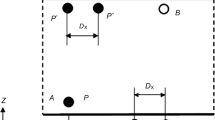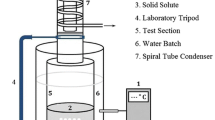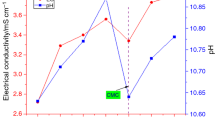Abstract
An experimental study was performed to measure benzoic acid diffusion coefficient in water-based γ-Al2O3 nanofluids at different temperatures. Measurements were carried out at 15, 20 and 25 °C. γ-Al2O3 nanoparticles with an average diameter of 10–20 nm were added into de-ionized water as the based fluid. Nanoparticles volume fractions used in the based fluid were 0.025, 0.05, 0.1, 0.2, 0.4 and 0.8 %. Measurements showed that the diffusion coefficients was not changed with nanoparticles concentration and no enhancement was found. Dependence of diffusion coefficients on nanoparticles concentration followed the same trend in all temperatures investigated in this work. Nano stirring and nano-obstacles could be regarded as two reasons for mass diffusivity changes in nanofluids.









Similar content being viewed by others
Abbreviations
- C:
-
Concentration (mol m−3)
- D:
-
Molecular diffusion coefficient (m2 s−1)
- m:
-
Mass (g)
- M:
-
Result which is function of independent variables
- Mw:
-
Molecular weight (g mol−1)
- q:
-
Rate of mass transfer (mol s−1)
- r:
-
Radial coordinate; test section radius (m)
- R:
-
Radius of benzoic acid sphere (m)
- t:
-
Time
- ∆t:
-
Time of diffusion (s)
- T:
-
Temperature (K)
- V:
-
Volume of working fluid (m3)
- wi :
-
Uncertainty in the ith independent variable
- wM :
-
Uncertainty in the result
- xi :
-
Independent variable
- ρ p :
-
Nanoparticles density (g cm−3)
- Φ:
-
Volume fraction of nanoparticles (%)
- \(\bar{\Phi}\) :
-
Dimensionless volume fraction of nanoparticles
- A:
-
Benzoic acid
- bulk:
-
Bulk
- f:
-
Final time of diffusion process
- o:
-
Start time of diffusion process; based fluid
- s:
-
Saturated concentration
References
Choi SUS (1998) Nanofluid technology: current status and future research. Argonne National Lab., Lemont
Fan J, Wang L (2011) Review of heat conduction in nanofluids. J Heat Transf 133(4):040801–040814
Kasaeian A, Eshghi AT, Sameti M (2015) A review on the applications of nanofluids in solar energy systems. Renew Sustain Energy Rev 43:584–598. doi:10.1016/j.rser.2014.11.020
Lomascolo M, Colangelo G, Milanese M, de Risi A (2015) Review of heat transfer in nanofluids: conductive, convective and radiative experimental results. Renew Sustain Energy Rev 43:1182–1198. doi:10.1016/j.rser.2014.11.086
Wen D, Lin G, Vafaei S, Zhang K (2009) Review of nanofluids for heat transfer applications. Particuology 7(2):141–150
Chen R, Lu M-C, Srinivasan V, Wang Z, Cho HH, Majumdar A (2009) Nanowires for enhanced boiling heat transfer. Nano Lett 9(2):548–553. doi:10.1021/nl8026857
Asadzadeh F, Esfahany MN, Etesami N (2012) Natural convective heat transfer of Fe3O4/ethylene glycol nanofluid in electric field. Int J Therm Sci 62:114–119
Syam Sundar L, Venkata Ramana E, Singh MK, Sousa ACM (2014) Thermal conductivity and viscosity of stabilized ethylene glycol and water mixture Al2O3 nanofluids for heat transfer applications: an experimental study. Int Commun Heat Mass Transf 56:86–95. doi:10.1016/j.icheatmasstransfer.2014.06.009
Beiki H, Nasr Esfahany M, Etesami N (2013) Laminar forced convective mass transfer of γ-Al2O3/electrolyte nanofluid in a circular tube. Int J Therm Sci 64:251–256. doi:10.1016/j.ijthermalsci.2012.09.004
Beiki H, Esfahany M, Etesami N (2013) Turbulent mass transfer of Al2O3 and TiO2 electrolyte nanofluids in circular tube. Microfluid Nanofluidics 15(4):501–508. doi:10.1007/s10404-013-1167-z
Krishnamurthy S, Bhattacharya P, Phelan PE, Prasher RS (2006) Enhanced mass transport in nanofluids. Nano Lett 6(3):419–423
Veilleux J, Coulombe S (2011) A dispersion model of enhanced mass diffusion in nanofluids. Chem Eng Sci 66(11):2377–2384. doi:10.1016/j.ces.2011.02.053
Saien J, Bamdadi H (2012) Mass transfer from nanofluid single drops in liquid–liquid extraction process. Ind Eng Chem Res 51(14):5157–5166
Olle B, Bucak S, Holmes TC, Bromberg L, Hatton TA, Wang DIC (2006) Enhancement of oxygen mass transfer using functionalized magnetic nanoparticles. Ind Eng Chem Res 45(12):4355–4363
Kim J-K, Jung JY, Kang YT (2007) Absorption performance enhancement by nano-particles and chemical surfactants in binary nanofluids. Int J Refrig 30(1):50–57
Komati S, Suresh AK (2008) CO2 absorption into amine solutions: a novel strategy for intensification based on the addition of ferrofluids. J Chem Technol Biotechnol 83(8):1094–1100
Ma X, Su F, Chen J, Bai T, Han Z (2009) Enhancement of bubble absorption process using a CNTs-ammonia binary nanofluid. Int Commun Heat Mass Transf 36(7):657–660. doi:10.1016/j.icheatmasstransfer.2009.02.016
Lee JK, Koo J, Hong H, Kang YT (2010) The effects of nanoparticles on absorption heat and mass transfer performance in NH3/H2O binary nanofluids. Int J Refrig 33(2):269–275
Jung J-Y, Lee J, Kang Y (2012) CO2 absorption characteristics of nanoparticle suspensions in methanol. J Mech Sci Technol 26(8):2285–2290. doi:10.1007/s12206-012-0609-y
Esmaeili Faraj SH, Nasr Esfahany M, Jafari-Asl M, Etesami N (2014) Hydrogen sulfide bubble absorption enhancement in water-based nanofluids. Ind Eng Chem Res 53(43):16851–16858
Feng W, Wen J, Fan J, Yuan Q, Jia X, Sun Y (2005) Local hydrodynamics of gas–liquid-nanoparticles three-phase fluidization. Chem Eng Sci 60(24):6887–6898. doi:10.1016/j.ces.2005.06.006
Park S-W, Choi B-S, Kim S-S, Lee B-D, Lee J-W (2008) Absorption of carbon dioxide into aqueous colloidal silica solution with diisopropanolamine. J Ind Eng Chem 14(2):166–174. doi:10.1016/j.jiec.2007.09.013
Fang X, Xuan Y, Li Q (2009) Experimental investigation on enhanced mass transfer in nanofluids. Appl Phys Lett 95(20):203108-1–203108-3
Veilleux J, Coulombe S (2010) A total internal reflection fluorescence microscopy study of mass diffusion enhancement in water-based alumina nanofluids. J Appl Phys 108(10):104316-1–104316-8
Turanov AN, Tolmachev YV (2009) Heat- and mass-transport in aqueous silica nanofluids. Heat Mass Transf 45(12):1583–1588
Gerardi C, Cory D, Buongiorno J, Hu L-W, McKrell T (2009) Nuclear magnetic resonance-based study of ordered layering on the surface of alumina nanoparticles in water. Appl Phys Lett 95(25):253104
Ozturk S, Hassan YA, Ugaz VM (2010) Interfacial complexation explains anomalous diffusion in nanofluids. Nano Lett 10(2):665–671. doi:10.1021/nl903814r
Subba-Rao V, Hoffmann PM, Mukhopadhyay A (2011) Tracer diffusion in nanofluids measured by fluorescence correlation spectroscopy. J Nanopart Res 13(12):6313–6319
Feng X, Johnson DW (2012) Mass transfer in SiO2 nanofluids: a case against purported nanoparticle convection effects. Int J Heat Mass Transf 55(13–14):3447–3453. doi:10.1016/j.ijheatmasstransfer.2012.03.009
Ashrafmansouri S-S, Nasr Esfahany M, Azimi G, Etesami N (2014) Experimental investigation of water self-diffusion coefficient and tracer diffusion coefficient of tert-butanol in water-based silica nanofluids. Int J Therm Sci 86:166–174. doi:10.1016/j.ijthermalsci.2014.07.002
Delgado JMPQ (2007) Experimental data of solubility at different temperatures: a simple technique. Heat Mass Transf 43(12):1311–1316. doi:10.1007/s00231-006-0209-4
Lozar J, Laguerie C, Couderc JP (1975) Diffusivité de l’acide benzoi’que dans l’eau: influence de la température. Can J Chem Eng 53(2):200–203. doi:10.1002/cjce.5450530208
Moffat RJ (1988) Describing the uncertainties in experimental results. Exp Thermal Fluid Sci 1(1):3–17
Delgado JMPQ (2007) Molecular diffusion coefficients of organic compounds in water at different temperatures. J Ph Equilib Diffus 28(5):427–432. doi:10.1007/s11669-007-9160-4
Prasher R, Bhattacharya P, Phelan PE (2006) Brownian-motion-based convective–conductive model for the effective thermal conductivity of nanofluids. J Heat Transf 128(6):588–595
Seyf HR, Nikaaein B (2012) Analysis of Brownian motion and particle size effects on the thermal behavior and cooling performance of microchannel heat sinks. Int J Therm Sci 58:36–44. doi:10.1016/j.ijthermalsci.2012.02.022
Blundell JE, Caudwell P, Gibbons C, Hopkins M, Naslund E, King N, Finlayson G (2012) Role of resting metabolic rate and energy expenditure in hunger and appetite control: a new formulation. Dis Model Mech 5(5):608–613. doi:10.1242/dmm.009837
Shima P, Philip J, Raj B (2009) Role of microconvection induced by Brownian motion of nanoparticles in the enhanced thermal conductivity of stable nanofluids. Appl Phys Lett 94(22):223101
Buongiorno J (2006) Convective transport in nanofluids. J Heat Transf 128(3):240–250
Acknowledgments
The authors would like to thank Dr. M. Nasr Esfahany for his constructive comments on the manuscript.
Author information
Authors and Affiliations
Corresponding author
Rights and permissions
About this article
Cite this article
Manouchehrian Fard, M., Beiki, H. Experimental investigation of benzoic acid diffusion coefficient in γ-Al2O3 nanofluids at different temperatures. Heat Mass Transfer 52, 2203–2211 (2016). https://doi.org/10.1007/s00231-015-1734-9
Received:
Accepted:
Published:
Issue Date:
DOI: https://doi.org/10.1007/s00231-015-1734-9




